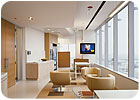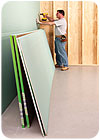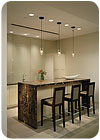

There are a host of mold-resistant products available that can also be part of an effective moisture and mold control strategy in combination with proper building design, construction and maintenance practices. This can significantly reduce typical problems in this area.
RESEARCH POINTS TO WATER INTRUSION
Research shows that the majority of moisture problems still originate from water intrusion caused by wet building materials, poor roof, window or other exterior flashing details, plumbing or HVAC system leaks and poor site drainage or flooding.
The one common element in all of these potential calamities is the introduction of excess moisture. Mold can grow on virtually any surface-glass, steel, fiberglass-all it needs are nutrients and moisture. Nutrients are as ubiquitous as organic fibers contained in most building materials or dust accumulation from construction and normal use. But without water, mold cannot grow. And moisture sources can be as innocent as window condensation or the installation of damp building materials-or closing up walls before materials have had a chance to dry.
Factors that can contribute to excess moisture and subsequent mold growth include poorly sized or installed ventilation systems, new materials that hold or trap moisture, and architectural design features that trap moisture. In addition, fast-track construction in which building materials have been allowed to get wet but not to dry out and inadequate maintenance during the building’s useful life all contribute to mold growth.

Mold-resistant products play an important role, but they must not be the primary defense against mold as moisture intrusion will inevitably lead to other problems in the building, too. It is possible to keep buildings dry and therefore less prone to moisture and mold problems. Many of these steps are not overly complicated-most constitute paying attention to details during the design, construction and maintenance of the building. Proper architectural design plays a vital role. In a desire to meet consumer tastes, for example, roof designs have become quite elaborate and may lead to roof planes draining into valleys that are inadequately flashed and detailed to handle the increased volume of water flowing to gutters and downspouts-this should be avoided.
Moisture-and therefore mold-can also be prevented from gaining a foothold by keeping building materials dry and scheduling trades so that critical junctures of the house (where the cladding meets the roof, for example) are properly flashed. If the roofer and the cladding contractor are not scheduled properly, flashing may not be installed properly, or at all. Window and door flashings are also essential and must be installed to deflect water to drain outside the weather resistant barrier and not into the wall.
VENTING OUTDOORS
Bathroom and kitchen vents must be vented outdoors-they must not empty into the attic. Exposed earth crawl space floors need to be covered by an impermeable plastic ground cover to prevent water vapor from entering the structure from the soil. The grade around new houses must slope away from the structure-one of the simplest and most important features that is often inadvertently compromised by the landscaping and needs to be checked every few years to make sure the back fill hasn’t settled in a manner that drains rain and sprinkler water runoff towards the foundation.
As noted at the beginning of this article, the only sure way to control mold is to control moisture, and mold resistant products, as good as they are, are no substitute for good design, good building practices and good maintenance. As we like to say, “Building systems manage moisture, products do not.” There are no simple product solutions for mold. No mold-resistant product, regardless of its composition, will perform as originally intended after repeated exposures to excess moisture.
This does not suggest, however, that mold-resistant products don’t play an important role, because they do. Proper moisture control is not a matter of stopping all moisture movement. It is a matter of minimizing the quantities of moisture that pass into and out of the structure and providing robustness in the building to allow time for water to drain and dry out.

Several manufacturers in the United States offer their own mold-resistant gypsum boards, such as USG’s Mold Tough gypsum board, National Gypsum Company’s Gold Bond Brand XP board, Temple-Inland’s ComfortGuard water and mold-resistant board and Lafarge North America’s Mold Defense drywall. These products were designed to actively inhibit mold growth on the surface paper, both back and front, and in the gypsum core. Utilizing proprietary technology, ingredients are added during manufacturing to protect the wallboard from moisture and mold.
In addition, some have followed the strategy of replacing the paper with a non-woven glass scrim for their moisture and mold resistant gypsum panels, such as Georgia-Pacific’s DensArmor Plus. These boards and panels are intended to be used in areas subjected to intermittent moisture including basements, garages, bathrooms (not tubs or showers) or areas that will unavoidably be exposed to wet weather during construction.
Ceilings are another place where mold can hide. What are the culprits in this space? In the plenum area above the ceiling, contributing factors include condensation on uninsulated or improperly maintained ductwork and cold water lines, and building or pipe leaks. Below the ceiling many factors can contribute to moisture: poor enclosure or exposure to outdoor elements, leaks from windows, slow air circulation, improper humidity control, low surface temperature, and even some indoor plants. One of the most serious sources of excess humidity can be improperly monitored and regulated nighttime and weekend HVAC economizer cycles or seasonal shutdowns as occurs in many schools during the summer.
CONQUERING MOLD IN CEILINGS
Design, operation and maintenance issues such as those mentioned above are damaging conditions. Repeated or persistent abuse will eventually take a toll on the building and its contents. However, mold-resistant ceiling tiles can provide a buffer period for identification of a problem and corrective action that will help the building through occasional events.
Several manufacturers help owners and specifiers address the issue of mold and mildew growth by providing products designed to fight mold, such as USG’s ClimaPlus Superior Performance panels, CertainTeed’s Aquarock and Armstrong’s HumiGuard ceiling tiles. These ceiling panels offer antimicrobial treatment for broad-spectrum control of fungi, mold, mildew, bacteria and yeast and algae.
The same caveat applies to ceilings as to all mold-resistant gypsum panels: Repeated exposure to excess moisture that does not allow drying to occur will eventually cause the mold resistance of any building product to deteriorate.
Currently, efforts are underway in ASTM Committees D01 and C11 to develop improved standard test methods for measuring the resistance to mold growth of building materials and to develop a standard specification for mold resistant gypsum boards and panels.
Today, there are advanced building methods and materials that help keep mold at bay. And now with a new generation of mold-resistant products, there is another useful tool to fight mold. However, we will not be successful in defeating mold until we address moisture and mold control through a building systems’ approach. Moisture intrusion is not inevitable if we design, build and maintain buildings in a way that prevents its entry into the structure. W&C


